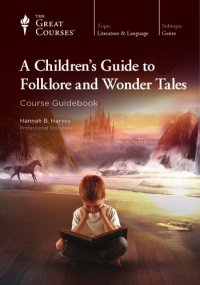
Ebook: A Children’s Guide to Folklore and Wonder Tales
Author: Hannah B. Harvey
- Genre: Literature // Folklore
- Series: The Great Courses
- Year: 2017
- Publisher: The Teaching Company
- Language: English
- pdf
People love stories—but why? As children and adults, we
interpret the adventures of our daily lives through narrative.
Classic narratives give us ways to see ourselves as heroes,
tricksters, and maybe even villains; they also give us a way to interpret
the foes and obstacles we encounter and to defeat them first in story,
so that we can go out with the strength to tackle them in reality.
Stories circumnavigate, rather than directly penetrate, themes and
questions. They draw a circle around listeners and pull us closer to
common understandings and meanings—and to each other, too. This
is the vision for this course: to draw your family closer together as you
hear stories and explore the deep themes and questions of powerful
classic tales.
This course’s lectures cluster around the basic genres of folktales
(folktales, animal folktales, pourquoi stories, fables, fairy tales, and
legends). Each lecture is relatively independent, allowing you to jump
to your favorite stories or the ones your family happens to be in the
mood for that day. With this in mind, the lectures do refer back to one
another and build on some key concepts, so completing the lectures in
order will enable you to feel a sense of trajectory.
Key concepts this course covers include rites of passage, the role
of trickster heroes, and the differences between oral stories and
written texts. Animal folktales and “magic” numbers also receive
attention. And the lectures discuss how stories vary across the world;
for example, three interconnected lectures on “Cinderella” explore
versions of the tale from France, Russia, and Iran, each showing a
progressively more proactive protagonist.
The course builds toward one concluding lecture, which returns to
previous tales to discuss the overarching themes and questions that
link genres and tale types. That lecture includes a final tale that
combines many of the themes and recurring motifs of the course.
The course concludes by pointing you toward recommended tale
collections and resources to continue your storytelling and sharing of
classic oral folklore and wondertales.
interpret the adventures of our daily lives through narrative.
Classic narratives give us ways to see ourselves as heroes,
tricksters, and maybe even villains; they also give us a way to interpret
the foes and obstacles we encounter and to defeat them first in story,
so that we can go out with the strength to tackle them in reality.
Stories circumnavigate, rather than directly penetrate, themes and
questions. They draw a circle around listeners and pull us closer to
common understandings and meanings—and to each other, too. This
is the vision for this course: to draw your family closer together as you
hear stories and explore the deep themes and questions of powerful
classic tales.
This course’s lectures cluster around the basic genres of folktales
(folktales, animal folktales, pourquoi stories, fables, fairy tales, and
legends). Each lecture is relatively independent, allowing you to jump
to your favorite stories or the ones your family happens to be in the
mood for that day. With this in mind, the lectures do refer back to one
another and build on some key concepts, so completing the lectures in
order will enable you to feel a sense of trajectory.
Key concepts this course covers include rites of passage, the role
of trickster heroes, and the differences between oral stories and
written texts. Animal folktales and “magic” numbers also receive
attention. And the lectures discuss how stories vary across the world;
for example, three interconnected lectures on “Cinderella” explore
versions of the tale from France, Russia, and Iran, each showing a
progressively more proactive protagonist.
The course builds toward one concluding lecture, which returns to
previous tales to discuss the overarching themes and questions that
link genres and tale types. That lecture includes a final tale that
combines many of the themes and recurring motifs of the course.
The course concludes by pointing you toward recommended tale
collections and resources to continue your storytelling and sharing of
classic oral folklore and wondertales.
Download the book A Children’s Guide to Folklore and Wonder Tales for free or read online
Continue reading on any device:

Last viewed books
Related books
{related-news}
Comments (0)